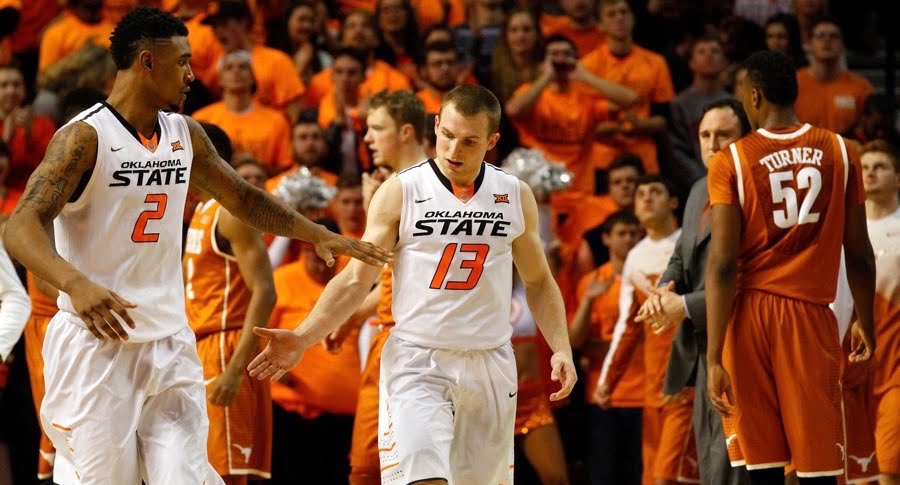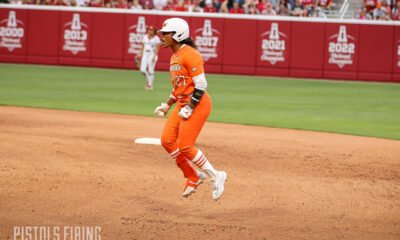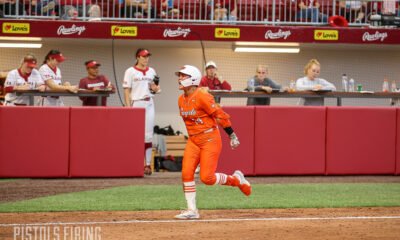Hoops
Comparing The Careers Of Keiton Page and Phil Forte

Phil Forte, Oklahoma State’s longest tenured player, is entering his fifth and final season of eligibility, after redshirting in 2014-2015 after an injury derailed his year. He already goes down as one of the better shooting guards in the history of the school, sitting at 1,307 points, already No. 22 in school history. He also ranks fourth in Cowboy basketball history with 244 career 3-pointers through three seasons (and three games last season), and 13th in school history in 3-point percentage at 38.9 percent.
Forte needs just 56 threes this season to overtake Keiton Page’s school record for the most threes made in Oklahoma State history, certainly attainable considering he’s averaging 79.3 threes per season in his first three full seasons. The comparisons between Page and Forte are fairly easy to make — they’re both undersized, scrappy, white shooting guards who will pull the trigger from anywhere on the floor. But how close are they really? I’d like to take a look at each of their careers and see where Forte sits at this point.
Who shoots the three better?
Thirty years from now, anybody that watched Page and Forte play will remember one thing above all else: threes. From the corner, from the top of the key, touching the center court logo, from Boone Pickens Stadium, maybe a couple from the parking lot across the street. Both dudes had and have range for days. Lets compare the two in terms of number of career games, threes made per game, threes attempted per game, and 3-point shooting percentage
Eerily similar numbers for 3 pointers made and 3 pointers attempted per game for the two.
- Forte: 2.4/6.2
- Page: 2.2/6.1
I was a little surprised that Page didn’t shoot more, as it felt like he had to carry a much heavier load on offense on his teams later in his career, whereas Forte played several seasons with the likes of Air Markel, Marcus Smart, and LB Nash (get buckets).
Where Forte does have the clear edge is in the shooting percentage. Forte has shot it from long range just over two percent higher than Page, and that’s even before his senior season. If Forte can even improve on his career number of 38.9 percent from three, he will further widen the gap.
Edge: Forte.
Defense counts too, right?
You bet it does. While both are considered by some to be a liability on defense due to their lack of size and relative athleticism, I watched both and sort of felt, just by the eye test, that Forte is a tad quicker than Keiton, resulting in a few more steals and loose rebounds tracked down (Lord knows they aren’t going up and getting many off the glass). Let’s take a look at a couple of defensive stats:
- Defense rebounding percentage (how many available defensive rebounds the player grabbed while on the floor)
- Total rebounding percentage (same stat, but overall, including both offensive and defensive rebounds)
- Steals percentage (average steals per game)
- Defensive win shares (an estimate of number of wins contributed by a player due to his defense)
- DBPM (Defensive Box Plus/Minus) (an estimate of how many defensive points per 100 possessions a player contributed above an average player)
Alright, so it’s pretty close, but the slight edge goes to Forte in defensive rebounds tracked down, while Page gets the nod in total rebounding percentage. The steals per game, the defensive win shares, and defensive box plus/minus also go to Forte, who (by basically rounding out as an average defender), gets the nod over Page.
Edge: Forte.
Overall Value
This one is the most important, obviously. Looking at the whole picture, who gets the nod? Here’s a pretty good run down of most important stats. That last one is pretty important: box score plus/minus. Again, this is the box score estimate of how many points a player contributed per 100 possessions above a league average player.
 They’re incredibly similar in many offensive statistics, including field goals per game and shooting percentages but overall, Phil has a slight edge. When you look at the defensive numbers, Forte is clearly the superior defender, giving him the overall edge.
They’re incredibly similar in many offensive statistics, including field goals per game and shooting percentages but overall, Phil has a slight edge. When you look at the defensive numbers, Forte is clearly the superior defender, giving him the overall edge.
Many believed that Phil Forte came to OSU as a throw-in in order to lock up five-star point guard Marcus Smart, but Forte has carved out a phenomenal collegiate career in Stillwater, and may very well leave as the most prolific three-point shooter in school history.
Forte will combine with reigning Big 12 Freshman of the Year Jawun Evans in the backcourt to give Brad Underwood one of the best backcourts in the Big 12, and will be vitally important in his last season to the Cowboys’ chances of returning to the NCAA Tournament. We’ll never forget the scrappiness and amazing shooting of Keiton Page, but Forte has him beat, ever so slightly.

-

 Football2 days ago
Football2 days agoOklahoma Transfer Gavin Freeman Commits to Oklahoma State
-

 Football4 days ago
Football4 days agoReport: Cornerback Jordan Reagan Enters Transfer Portal
-

 Softball3 days ago
Softball3 days agoOSU Softball: Cowgirls Secure Bedlam Series Win with 6-2 Victory against Sooners
-

 Softball3 days ago
Softball3 days agoOSU Softball: Godwin Leads Cowgirls Past Sooners in First Game of Bedlam Series







